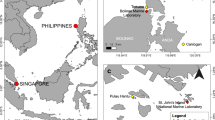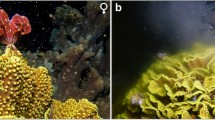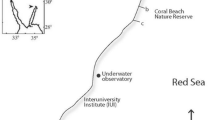Abstract
Sarcophyton elegans is a common symbiotic (zooxanthellate) octocoral species in the shallow waters of the Great Barrier Reef (GBR). Study of a population at Lizard Island (14°40′S, 145°28′E) on the GBR from October 1991 to January 1994 revealed that, as is typical of tropical alcyonarian corals, S. elegans is a gonochoric broadcast spawner with a 1:1 sex ratio. Sexual reproduction was closely correlated with colony size, with first reproduction at 13-cm basal stalk circumference for females and 12 cm for males. Oogenesis took 19–24 months, with a new cycle commencing every year, and spermatogenesis took 10–12 months. The majority of gametes were released during the annual austral mass coral spawning event after the full moon in November, but gametes were also released after the full moon in each month between August and February. All autozooid polyps participated in reproduction, but those at the outer edge of a colony released their gametes first. During subsequent months, the polyps closer to the center of the colony released their gametes. This is a novel strategy of gamete release, reported here for the first time, which accommodates the demands of feeding and reproduction in a different way than other corals where individual polyps have separate feeding or reproductive roles. Colonies upstream in the prevailing current spawned up to 1 month earlier than those downstream and ceased 1 month earlier. The mechanism controlling this spatial differentiation in spawning time, repeatedly observed over three seasons, is unknown. Sarcophyton elegans appears to have a dual strategy of providing protection for its gametes by releasing most of them concurrently with the single, annual mass spawning of a large number of cnidarians, while also hedging its bets by individual colonies spawning a fraction of their gametes over an extended period of 6 months.






Similar content being viewed by others
References
Achituv Y, Benayahu Y (1990) Polyp dimorphism and functional sequential hermaphrodism the soft coral Heteroxenia fuscescens (Octocorallia). Mar Ecol Prog Ser 64:263–269
Alino PM, Coll JC (1989) Observations on the synchronized mass spawning and postsettlement activity of octocorals on the Great Barrier Reef, Australia: biological aspects. B Mar Sci 45:697–707
Atkinson S, Atkinson MJ (1992) Detection of estradiol-17b during a mass coral spawn. Coral Reefs 11:33–35
Babcock RC (1990) Reproduction and development of the blue coral Heliopora coerulea (Alcyonaria: Coenothecalia). Mar Biol 104:475–481
Babcock RC (1991) Comparative demography of three species of scleractinian corals using age and size dependent classifications. Ecol Monogr 61:225–244
Babcock RC, Bull GD, Harrison PL, Heyward AJ, Oliver JK, Wallace CC, Willis BL (1986) Synchronous spawnings of 105 scleractinian coral species on the Great Barrier Reef. Mar Biol 90:379–394
Bastidas C, Benzie JAH, Fabricius KE (2002) Genetic differentiation among populations of the brooding soft coral Clavularia koellikeri on the Great Barrier Reef. Coral Reefs 21:233–241
Bastidas C, Cróquer A, Zubillaga AL, Ramos R, Kortnik V, Weinberger C, Márquez LM (2005) Coral mass- and split-spawning at a coastal and an Offshore Venezuelan Reefs, southern Caribbean. Hydrobiologia 541:101–106
Benayahu Y (1997) Developmental episodes in reef soft corals: ecological and cellular determinants. Proceedings of the 8th international coral reef symposium 2:1213–1218
Benayahu Y, Loya Y (1984) Life history studies on the Red Sea octocoral Xenia macrospiculata (Gohar 1940). I. Annual dynamics on gonadal development. Biol Bull 166:32–43
Benayahu Y, Loya Y (1986) Sexual reproduction of a soft coral: synchronous and brief annual spawning of Sarcophyton glaucum (Quoy and Gaimard, 1883). Biol Bull 70:32–42
Benayahu Y, Weil D, Kleinmann M (1990) Radiation of broadcasting and brooding patterns in coral reef alcyonaceans. Adv Invertebrate Reprod 5:323–328
Brazeau DA, Lasker HR (1990) Sexual reproduction and external brooding by the Caribbean gorgonian Briareum asbestinum. Mar Biol 104:465–474
Brito TAS, Tyler PA, Clarke A (1997) Reproductive biology of the Antarctic octocoal Thouarella variabilis Wright and Studer 1889. In: Den Hartog JC (ed) Proceedings of the sixth international conference on coelenterate biology. National Natuurhistorisch Museum, Leiden, pp 63–69
Carlon DB (1999) The evolution of mating systems in tropical reef corals. Trends Ecol Evol 14:491–495
Coll JC, Tapiolas DM, Bowden BF, Webb L, Marsh H (1983) Transformation of soft coral (Coelenterata: Octocorallia) terpenes by Ovula ovum (Mollusca: Prosobranchia). Mar Biol 74:35–40
Coma R, Zabala M, Gili JM (1995) Sexual reproductive effort in the Mediterranean gorgonian Paramuricea clavata. Mar Ecol Prog Ser 117:185–192
Cordes EE, Nybakken JW, VanDykhuizen G (2001) Reproduction and growth of Anthomastus ritteri (Octocorallia: Alcyonacea) from Monterey Bay, California, USA. Mar Biol 138:491–501
Dahan M, Benayahu Y (1997) Clonal propagation by the azoozanthellate soft coral Dendronephthya hemprichi. Coral Reefs 16:5–12
Dinesen ZD (1983) Patterns in the distribution of soft corals across the central Great Barrier Reef. Coral Reefs 1:229–236
Dinesen ZD (1985) Aspects of the life history of a stolon bearing species of Efflatonuaria. Proceedings of the 5th international coral reef conference, Tahiti. 6:89–94
Fabricius KE (1995) Slow population turnover in the soft coral genera Sinularia and Sarcophyton in mid- and outer-shelf reefs of the Great Barrier Reef. Mar Ecol Prog Series 126:145–152
Fabricius KE, Alderslade P (2001) Soft corals and sea fans: a comprehensive guide to the tropical shallow water genera of the central-west Pacific, the Indian Ocean and the Red Sea. Australian Institute of Marine Science
Farrant PA (1986) Gonad development and the planulae of the temperate Australian soft coral Capnella gaboensis. Mar Biol 92:381–392
Fautin DG (2002) Reproduction of Cnidaria. Can J Zool 80:1735–1754
Francis L (1976) Social organization within clones of the sea anemone Anthopleura elegantissima. Biol Bull 150:361–376
Fuchs Y, Douek J, Rinkevich B, Ben-Shlomo R (2006) Gene diversity and mode of reproduction in the brooded larvae of the coral Heteroxenia fuscescens. J Hered 97:493–498
Giese AC, Pearse JS (1974) Introduction: general principles. In: Giese AC, Pearse JS (eds) Reproduction of marine invertebrates, vol 1. Academic Press, New York, pp 1–49
Glynn PW, Gassman NJ, Eakin CM, Smith DB, Guzman HM (1991) Reef coral reproduction in the eastern Pacific Costa Rica, Panama, and Galapagos Islands (Ecuador) I. Pocilloporidae. Mar Biol 109:355–368
Gohar HAF (1940) Studies on the Xeniidae of the Red Sea. Publ Mar Biol Stn Ghardaqa 2:27–118
Gori A, Linares C, Rossi S, Coma R, Gili JM (2007) Spatial variability in reproductive cycle of the gorgonians Paramuricea clavata and Eunicella singularis (Anthozoa, Octocorallia) in the Western Mediterranean Sea. Mar Biol 151:1571–1584
Grigg RW (1977) Population dynamics of two gorgonian corals. Ecology 58:278–290
Gutierrez-Rodrıguez C, Lasker HR (2004) Reproductive biology, development, and planula behavior in the Caribbean gorgonian Pseudopterogorgia elisabethae. Invertebr Biol 123:54–67
Hall VR, Hughes YP (1996) Reproductive strategies of modular organisms: comparative studies of reef-building corals. Ecology 77:950–963
Harrison PL, Wallace CC (1990) Reproduction, dispersal and recruitment of scleractinian corals. In: Dubinsky Z (ed) Ecosystems of the world, 25th edn. Elsevier, Amsterdam, the Netherlands, pp 133–207
Harrison PL, Babcock RC, Bull GD, Oliver JK, Wallace CC, Willis BL (1984) Mass spawning in tropical coral reefs. Science 223:1186–1189
Hartnoll RG (1975) The annual cycle of Alcyonium digitatum. Eustarine Coastal Mar Sci 3:71–75
Harvell CD (1984) Predator-induced defense in a marine bryozoan. Science 224:1357–1359
Harvell CD, Grosberg CD (1988) The timing of sexual maturity in clonal animals. Ecology 69:1855–1864
Hayashibara T, Shimoike K, Kimura T, Hosoya S, Heyward A, Harrison P, Kudo K, Omori M (1993) Patterns of coral spawning at Akajima Island, Okinawa, Japan. Mar Ecol Prog Ser 101:253–262
Hwang SJ, Song JI (2007) Reproductive biology and larval development of the temperate soft coral Dendronephthya gigantea (Alcyonacea: Nephtheidae). Mar Biol 152:273–284
Kahng SE, Benayahu Y, Wagner D, Rothe N (2008) Sexual reproduction in the invasive octocoral Carijoa riisei in Hawaii. B Mar Sci 82:1–17
Kruger A, Schleyer MH, Benayahu Y (1998) Reproduction in Anthelia glauca (Octocorallia: Xeniidae). I. Gametogenesis and larval brooding. Mar Biol 131:423–432
Lasker HR, Brazeau DA, Calderon J, Coffroth MA, Coma R, Kim K (1996) In situ rates of fertilization among broadcast spawning gorgonian corals. Biol Bull 190:45–55
Levitan DR (1996) Effects of gamete traits on fertilization in the sea and the evolution of sexual dimorphism. Nature 382:153–155
McFadden CS, Donahue R, Hadland BK, Weston R (2001) A molecular phylogenetic analysis of reproductive trait evolution in the soft coral genus Alcyonium. Evolution 55:54–67
Penland L, Kloulechad J, Idip D, van Woesik R (2004) Coral spawning in the western Pacific Ocean is related to solar insolation: evidence of multiple spawning events in Palau. Coral Reefs 23:133–140
Ribes M, Coma R, Rossi S, Micheli M (2007) The cycle of gonadal development of Eunicella singularis (Cnidaria : Octocorallia): trends on sexual reproduction in Mediterranean gorgonians. Invertebr Biol 126:307–317
Richmond RH, Hunter CL (1990) Reproduction and recruitment of corals: comparisons among the Caribbean, the Tropical Pacific, and the Red Sea. Mar Ecol Prog Ser 60:185–203
Rosser NL, Gilmour JP (2008) New insights into patterns of coral spawning on Western Australian reefs. Coral Reefs 27:345–349
Santangelo G, Carletti E, Maggi E, Bramanti L (2003) Reproduction and population sexual structure of the overexploited Mediterranean red coral Corallium rubrum. Mar Ecol Prog Ser 248:99–108
Schleyer MH, Kruger A, Benayahu Y (2004) Reproduction and the unusual condition of hermaphroditism in Sarcophyton glaucum (Octocorallia, Alcyoniidae) in KwaZulu-Natal, South Africa. Hydrobiologia 530(531):399–409
Slattery M, Hines GA, Starmer J, Paul VJ (1999) Chemical signals in gametogenesis, spawning, and larval settlement and defense of the soft coral Sinularia polydactyla. Coral Reefs 18:75–84
Slattery M, Starmer J, Paul VJ (2001) Temporal and spatial variation in defensive metabolites of the tropical Pacific soft corals Sinularia maxima and S. polydactyla. Mar Biol 138:1183–1193
Stearns SC (1992) The evolution of life histories. Oxford University Press, Oxford England
Tarrant AM (2005) Endocrine-like signaling in cnidarians: Current understanding and implications for ecophysiology. Integr Comp Biol 45:201–214
Veron JEN (1993) Corals of Australia and the Indo-Pacific. University of Hawaii Press, Honolulu
Winsor L (1984) (Compilation) Manual of basic zoological microtechniques for light microscopy. School Biol Sci, James Cook University of North Queensland, Townsville, Australia
Yamazato K, Sato M, Yamashiro H (1981) Reproductive biology of an alcyonacean coral, Lobophytum crassum Marenzeller. Proceedings of the fourth international coral reef symposium 2:671–678
Acknowledgments
We gratefully acknowledge the staff at Lizard Island Research Station for a friendly working atmosphere and for collecting monthly tissue samples during the absence of MH from the station. L. Winsor at James Cook University gave invaluable histological advice, P. Muir assisted in the laboratory. P. Alderslade (Northern Territory Museum, Darwin) confirmed the identification of the Sarcophyton elegans. M. Cuhra, M. Egerrup, H. Grossman, K. Martin-Smith, G. Smith, J.-L. Solandt and many others assisted in the field. J. Hellström assisted with the histology figures. The comments by J. Blyth, J. Spens and two anonymous reviewers improved earlier drafts of the manuscript. J. Painter edited the text. The study was supported by the Australian European Awards Program, E & G Ehrnrooth Foundation, Finnish Academy, Oskar Öflund Foundation and Swedish Cultural Foundation in Finland. The samples were collected with a permit from the Great Barrier Reef Marine Park Authority.
Author information
Authors and Affiliations
Corresponding author
Additional information
Communicated by J. P. Grassle.
Rights and permissions
About this article
Cite this article
Hellström, M., Kavanagh, K.D. & Benzie, J.A.H. Multiple spawning events and sexual reproduction in the octocoral Sarcophyton elegans (Cnidaria: Alcyonacea) on Lizard Island, Great Barrier Reef. Mar Biol 157, 383–392 (2010). https://doi.org/10.1007/s00227-009-1325-8
Received:
Accepted:
Published:
Issue Date:
DOI: https://doi.org/10.1007/s00227-009-1325-8




